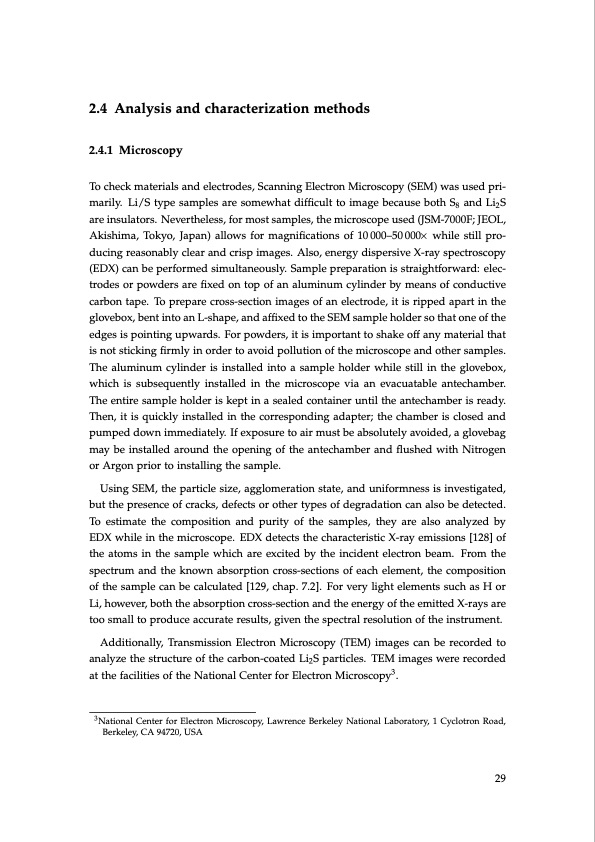
PDF Publication Title:
Text from PDF Page: 029
2.4 Analysis and characterization methods 2.4.1 Microscopy To check materials and electrodes, Scanning Electron Microscopy (SEM) was used pri- marily. Li/S type samples are somewhat difficult to image because both S8 and Li2S are insulators. Nevertheless, for most samples, the microscope used (JSM-7000F; JEOL, Akishima, Tokyo, Japan) allows for magnifications of 10000–50000× while still pro- ducing reasonably clear and crisp images. Also, energy dispersive X-ray spectroscopy (EDX) can be performed simultaneously. Sample preparation is straightforward: elec- trodes or powders are fixed on top of an aluminum cylinder by means of conductive carbon tape. To prepare cross-section images of an electrode, it is ripped apart in the glovebox, bent into an L-shape, and affixed to the SEM sample holder so that one of the edges is pointing upwards. For powders, it is important to shake off any material that is not sticking firmly in order to avoid pollution of the microscope and other samples. The aluminum cylinder is installed into a sample holder while still in the glovebox, which is subsequently installed in the microscope via an evacuatable antechamber. The entire sample holder is kept in a sealed container until the antechamber is ready. Then, it is quickly installed in the corresponding adapter; the chamber is closed and pumped down immediately. If exposure to air must be absolutely avoided, a glovebag may be installed around the opening of the antechamber and flushed with Nitrogen or Argon prior to installing the sample. Using SEM, the particle size, agglomeration state, and uniformness is investigated, but the presence of cracks, defects or other types of degradation can also be detected. To estimate the composition and purity of the samples, they are also analyzed by EDX while in the microscope. EDX detects the characteristic X-ray emissions [128] of the atoms in the sample which are excited by the incident electron beam. From the spectrum and the known absorption cross-sections of each element, the composition of the sample can be calculated [129, chap. 7.2]. For very light elements such as H or Li, however, both the absorption cross-section and the energy of the emitted X-rays are too small to produce accurate results, given the spectral resolution of the instrument. Additionally, Transmission Electron Microscopy (TEM) images can be recorded to analyze the structure of the carbon-coated Li2S particles. TEM images were recorded at the facilities of the National Center for Electron Microscopy3. 3National Center for Electron Microscopy, Lawrence Berkeley National Laboratory, 1 Cyclotron Road, Berkeley, CA 94720, USA 29PDF Image | Lithium-Sulfur Battery: Design, Characterization, and Physically-based Modeling

PDF Search Title:
Lithium-Sulfur Battery: Design, Characterization, and Physically-based ModelingOriginal File Name Searched:
Dissertation_David_N._Fronczek_The_Lithium_Sulfur_Battery.pdfDIY PDF Search: Google It | Yahoo | Bing
Sulfur Deposition on Carbon Nanofibers using Supercritical CO2 Sulfur Deposition on Carbon Nanofibers using Supercritical CO2. Gamma sulfur also known as mother of pearl sulfur and nacreous sulfur... More Info
CO2 Organic Rankine Cycle Experimenter Platform The supercritical CO2 phase change system is both a heat pump and organic rankine cycle which can be used for those purposes and as a supercritical extractor for advanced subcritical and supercritical extraction technology. Uses include producing nanoparticles, precious metal CO2 extraction, lithium battery recycling, and other applications... More Info
| CONTACT TEL: 608-238-6001 Email: greg@infinityturbine.com | RSS | AMP |